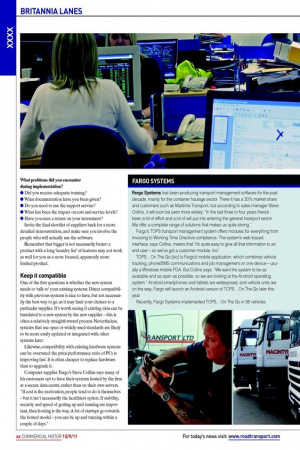FARGO SYSTEMS
Page 35

Page 36

If you've noticed an error in this article please click here to report it so we can fix it.
Fargo Systems has been producing transport management software for the past decade, mainly for the container haulage sector. There it has a 30% market share and customers such as Maritime Transport, but according to sales manager Steve Collins, it will soon be seen more widely: “In the last three to four years there’s been a lot of effort and a lot of will put into entering the general transport sector. We offer a complete range of solutions that makes us quite strong.” Fargo’s TOPS transport management system offers modules for everything from invoicing to Working Time Directive compliance. The system’s web-based interface, says Collins, means that “it’s quite easy to give all that information to an end user – so we’ve got a customer module, too”.
TOPS... On The Go [sic] is Fargo’s mobile application, which combines vehicle tracking, phone/SMS communications and job management on one device – usually a Windows mobile PDA. But Collins says: “We want the system to be as available and as open as possible, so we are looking at the Android operating system.” Android smartphones and tablets are widespread, and vehicle units are on the way; Fargo will launch an Android version of TOPS... On The Go later this year.
Recently, Fargo Systems implemented TOPS... On The Go in 38 vehicles belonging to container haulier MacIntyre Transport. Operators can assign jobs to drivers via the PDA, and the driver can use it to accept the job. Job status on arrival, departure, load, unload and delays are automatically updated. The system captures PoD [WHAT THIS?], manages driver timesheets and deals with defect reporting.
Macintyre director Paul Miller says: “Being able to manage jobs from start to finish without operators and drivers being constantly on the phone saves a great deal of time and means that we can optimise efficiency and service for our clients.” The firm plans to roll out the system across the rest of its 120-vehicle fleet.
Sidebar: MicroliseA recent trial conducted by the Freight Transport Association (FTA) and Microlise set out to prove that telematics and fleet management can offer a good return on investment, even for smaller fleets.
Over three months, waste management firm Vetspeed fitted seven of its 40 vehicles with a Microlise telematics system. This was not revealed to the drivers for five weeks, after which the fuel consumption and driving data was analysed, and the results given to the drivers. After a second period of trials, the monitored drivers had cut their fuel consumption by 0.43mpg, despite severe weather conditions. This could potentially save Vetspeed around £13,000 a year.
According to transport manager Gary Gates: “We were not in any doubt that our drivers would perform well, but we wanted to see whether they could perform better. By allowing us to look at things like engine idling, for example, we were able to share with our drivers ways they could finesse their driving behaviour. We are talking fine tuning here, not wholesale changes, but the results are well worth it.” Awards were given to the ‘best’ and ‘most improved’ drivers from the trial. Since the end of the exercise, Vetspeed’s productivity has improved by 200 drops a month due to better routeing and closer driver monitoring. The FTA’s Julian Barker adds: “It doesn’t really matter how small a fleet is, being able to ‘drill down’ data to address areas of performance or even non-compliance is very useful for any company.”

















































